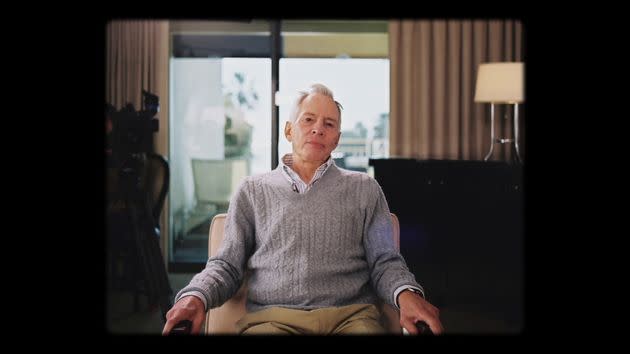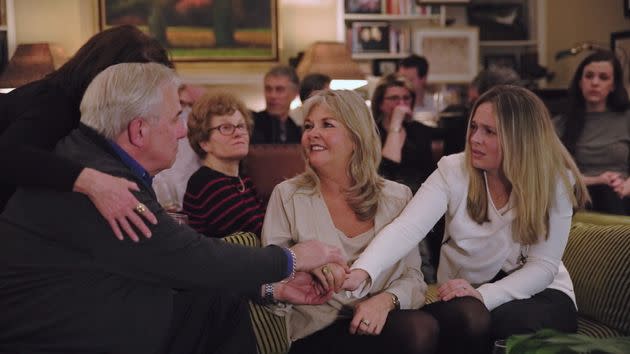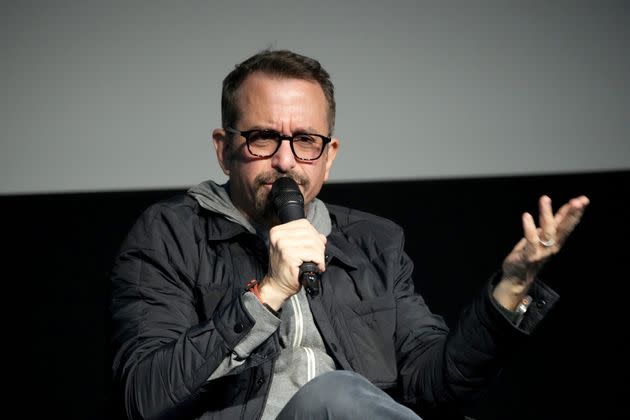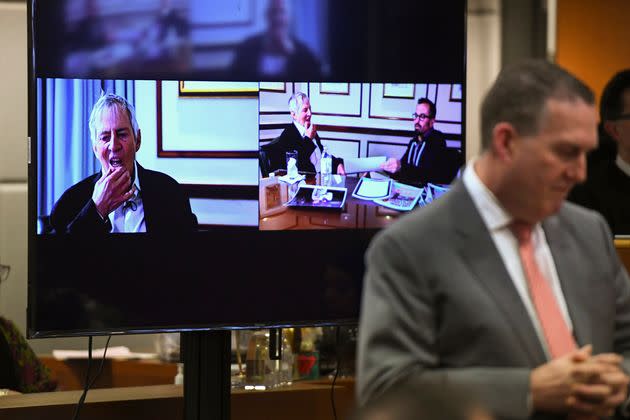'The Jinx: Part 2' Can't Top The Original — But You'll Still Get Sucked In
- Oops!Something went wrong.Please try again later.
- Oops!Something went wrong.Please try again later.
“What the hell have I done? Killed them all, of course.” Those jaw-dropping and bone-chilling two sentences at the end of HBO’s “The Jinx” gripped viewers in March 2015. It was one of those pop culture moments that if you were watching it, you might still remember where you were at the time.
In incidents spanning several decades, the docuseries’ subject, real estate scion Robert Durst, had been the prime suspect in the disappearance of his first wife, Kathie, and the murder of his close friend Susan Berman. He was also acquitted in the murder and dismemberment of a neighbor, Morris Black, even after saying he did it.
Now, as he went to the bathroom while still connected to a microphone, he could be heard muttering to himself, “There it is, you’re caught.”
Durst’s apparent confession capped off a dramatic series of events when “The Jinx” aired in early 2015. The night before the finale, the FBI arrested Durst in connection with Berman’s murder, in large part due to new evidence uncovered in the docuseries.
“The Jinx: The Life and Deaths of Robert Durst,” which exposed the ways Durst’s wealth insulated him from consequences for all those years, was stunning television. In retrospect, the series, co-created and directed by Andrew Jarecki, came at the beginning of a massive wave of true-crime pop culture projects that continues today (and has arguably run its course). “The Jinx” premiered just months after the podcast phenomenon “Serial,” and by the end of 2015, there was the Netflix docuseries “Making a Murderer.”

Nine years and dozens of true-crime TV series and podcasts later, “The Jinx” is back with another six installments, the first of which premieres Sunday night on HBO. Last fall, when the network announced Part 2 was coming, it was surprising. Where would this new season fit into the true-crime explosion that the original helped ignite? And was there really enough material for six more episodes?
Watching the finished product now, at first, it’s unclear if there are a sufficient amount of revelatory moments to merit another season of the Durst saga. We know how this all ends: In the fall of 2021, Durst finally got his comeuppance when a Los Angeles jury convicted him of murdering Berman. Months later, he died in prison at the age of 78, after a bout with COVID-19 exacerbated previous health issues.
But stick with the new season and, against all odds, it somehow is still riveting to watch. The first episode refreshes viewers’ memories, transporting us back to 2015. The night of the finale, Jarecki’s cameras were rolling at a watch party he organized for the series’ interviewees, including Kathie Durst’s family and various investigators and prosecutors who had tried to catch Durst over the years (including former Westchester County District Attorney Jeanine Pirro, before she went full Trump acolyte). Just as audiences did, the attendees gasp at Durst’s apparent confession, as we see in the episode. While the premiere episode takes a dim memory from nine years ago and vividly brings us back to that cultural moment, it’s not exactly full of revelatory information.

The dramatic arc of the season becomes clearer by the second episode and coalesces in Episodes 3 and 4, which cover Durst’s court proceedings, beginning in 2017 and culminating in the 2021 trial. (Critics received these four episodes, out of six total, ahead of the premiere Sunday.) In reconvening to make “The Jinx: Part 2,” Jarecki and his team aimed to dig “into the issue of complicity,” as he explained at a press conference earlier this week.
“We would always say while we were making Part 1: ‘How do you kill three people over 30 years and get away with it?’ It takes a village,” he said. “So it’s easy to say: ‘Well, Bob Durst is a crazy guy, and he did all these terrible crimes.’ But if you pull the camera back, you realize that there’s a constellation of people who looked the other way or helped in some way.”
Once the season really gets going, it’s fascinating to see which of Durst’s loyal friends, associates and enablers decide to turn on him during the trial — or, in some cases, unwittingly implicate themselves in pretty stunning ways during testimony.
In getting people to speak to them this time around, Jarecki and co-creator Zac Stuart-Pontier explained that it was more difficult, given the stakes. Part 1 was “largely the telling of a series of stories that have happened in the past,” bringing them to a wider audience. Part 2 is about what, at the time of filming, were ongoing criminal proceedings.
“And so the urgency is much higher. The anxiety level for a lot of the people involved is much higher,” Jarecki said. “For the first time, these people are saying, ‘Well, maybe this is not so good for me. And maybe there were things that I did that I’m not proud of, or I don’t want revisited, or things that seemed OK in the moment but in retrospect now, maybe it wasn’t such a good idea to go to the UPS and put $118,000 in a bag and send it to Bob Durst when he was about to go on the run.’”

“There’s a sort of cavalier attitude in that first season by people who have done some potentially bad things. I would say in Part 2, people have done more bad things, and they’re now in some way being held accountable for that. So getting people to participate in Part 2 was actually a lot harder,” he said. “There were all different ways of getting them to do it. But ultimately they knew they had to do it.”
Throughout Part 2, there’s also a meta quality, knowing how much the docuseries itself is now part of the Durst saga. Over the years, “The Jinx” has faced scrutiny and debate over the filmmakers’ choices and documentary ethics. The meta aspects of the series don’t get explored enough in these new episodes — though, understandably, too many self-references might have made the docuseries collapse on itself.
Much of Part 2 relies on a trove of Durst’s colorful prison phone calls to his wife, friends, lawyers and other associates. In one of them, he screeches: “The dumbest thing was doing Jarecki! Oh, God, ‘The Jinx.’”
Everyone, and especially Durst, knows that his hours of interviews with Jarecki in the original series precipitated his undoing. In fact, laying the blame on “The Jinx” became part of his defense team’s strategy during Durst’s trial, as Jarecki explained.
“They wanted to have a big smoking gun, and I think they thought it was going to be the film. They said, ‘Well, we’re going to prove that the filmmakers tricked Bob,’ or ‘we’re going to prove that the filmmakers made it seem like Bob was guilty because that was going to make for better TV,’ and they said it a lot. Early on, Dick DeGuerin, his lawyer, said: ‘I think these filmmakers, they make good TV, but it’s not the truth,’” Jarecki said this week. “Little by little, that kind of fell away when they realized there wasn’t going to be any low-hanging fruit there.”

Somehow, there’s something fascinating about getting sucked back into the Durst saga after nine years, even as most everything about the media landscape — and, for that matter, the world — has shifted. The drama of these new episodes largely comes from taking in the coterie of wild characters in Durst’s orbit and wondering whether they’re unreliable narrators and showmen. And Durst himself remains a strangely beguiling villain who never stops talking.
“Everybody’s just going to work together to get me the fuck out of here,” he says during one of his prison phone calls in the fourth episode, when he decides to take the stand in his own trial.
At the end of Episode 1, it’s hard to fathom how this new season goes on for six episodes, the same length as the 2015 series. Is there really that much more to say about Robert Durst? Yet, by the time we dig into the meat of the season, it still feels like there was plenty more that was likely left on the cutting room floor.
In the years since the original run of “The Jinx,” the true-crime genre has overflowed into a cesspool of what are too often exploitative and sensationalized stories mined for our consumption. “The Jinx” is not above reproach. However, by remaining focused on the corrosiveness of wealth and power, the series stays relatively grounded, despite its entertainment value and exhibitionist techniques.
In a lot of ways, the Durst saga isn’t that deep: a ludicrously rich white man, who quite obviously has committed monstrous acts, evading consequences — until he couldn’t stop talking. That’s what makes “The Jinx” easier to stomach, even if it’s still a bit conflicting to watch it as entertainment.
It would be a fool’s errand to try to top “killed them all, of course,” five words that are cemented in TV history. Part 2 isn’t likely to have as dramatic of a conclusion. Maybe that’s for the best.
“The Jinx: Part 2” premieres Sunday night on HBO.
